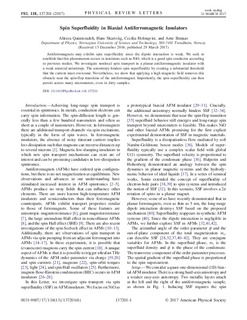| dc.contributor.author | Qaiumzadeh, Alireza | |
| dc.contributor.author | Skarsvåg, Hans Langva | |
| dc.contributor.author | Holmqvist, Cecilia | |
| dc.contributor.author | Brataas, Arne | |
| dc.date.accessioned | 2018-01-04T12:53:23Z | |
| dc.date.available | 2018-01-04T12:53:23Z | |
| dc.date.created | 2017-04-14T16:25:27Z | |
| dc.date.issued | 2017 | |
| dc.identifier.issn | 0031-9007 | |
| dc.identifier.uri | http://hdl.handle.net/11250/2475692 | |
| dc.description.abstract | Antiferromagnets may exhibit spin superfluidity since the dipole interaction is weak. We seek to establish that this phenomenon occurs in insulators such as NiO, which is a good spin conductor according to previous studies. We investigate nonlocal spin transport in a planar antiferromagnetic insulator with a weak uniaxial anisotropy. The anisotropy hinders spin superfluidity by creating a substantial threshold that the current must overcome. Nevertheless, we show that applying a high magnetic field removes this obstacle near the spin-flop transition of the antiferromagnet. Importantly, the spin superfluidity can then persist across many micrometers, even in dirty samples. | nb_NO |
| dc.language.iso | eng | nb_NO |
| dc.publisher | American Physical Society | nb_NO |
| dc.relation.uri | https://arxiv.org/pdf/1612.07440.pdf | |
| dc.title | Spin Superfluidity in Biaxial Antiferromagnetic Insulators | nb_NO |
| dc.type | Journal article | nb_NO |
| dc.type | Peer reviewed | nb_NO |
| dc.description.version | publishedVersion | nb_NO |
| dc.source.volume | 118 | nb_NO |
| dc.source.journal | Physical Review Letters | nb_NO |
| dc.source.issue | 13 | nb_NO |
| dc.identifier.doi | 10.1103/PhysRevLett.118.137201 | |
| dc.identifier.cristin | 1465079 | |
| dc.relation.project | EC/H2020/669442 | nb_NO |
| dc.description.localcode | © 2017 American Physical Society | nb_NO |
| cristin.unitcode | 194,66,20,0 | |
| cristin.unitname | Institutt for fysikk | |
| cristin.ispublished | true | |
| cristin.fulltext | postprint | |
| cristin.qualitycode | 2 | |
